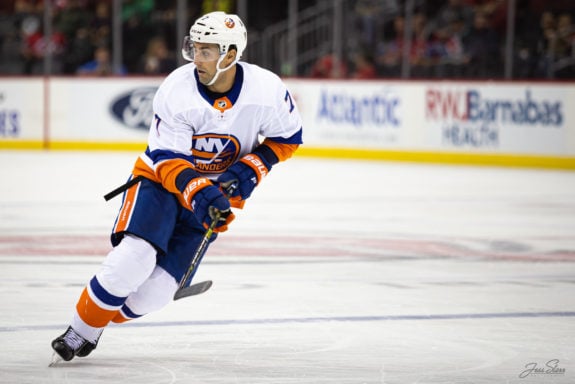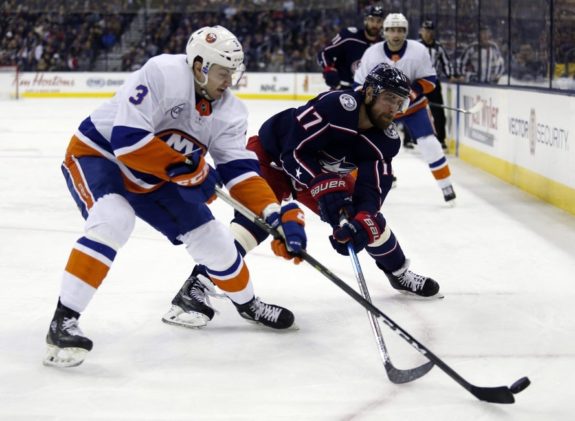The New York Islanders won Game 5 with a 5-4 victory over the Boston Bruins to give them a 3-2 series lead, allowing the team to potentially advance to the next round in the upcoming game. Game 5 was highlighted by the power play, where the Islanders scored three of their five goals and ultimately controlled the game. For a team that possessed a below-average power-play unit in the regular season, scoring on only 18.75 percent of opportunities, the recent success has been one of bewilderment. How has the power-play unit been able to score nine goals in the Stanley Cup Playoffs? Moreover, if the unit continues to be successful, how far can it carry the team? So far, the success has helped steal Game 5 in Boston, leading to a series-clinching game on Wednesday night if they win again.
Puck Movement
The power play has taken off, in large part because of their quick passes and effective puck movement. Game 2 saw the Islanders score their third goal of the 4-3 overtime in large part because of the designed play from Mathew Barzal to Anthony Beavillier, who quickly found Jean-Gabriel Pageau for the power-play goal. In the recent victory, two of the goals on the man-advantage had to be credited to excellent passes that were able to find open skaters in front of the net or with easy scoring opportunities. Kyle Palmieri and Jordan Eberle each found the back of the net from the designed quick passes, both of which helped build the momentum for the Islanders in the game, which at the end of the second period saw the team with a 4-2 lead.

The Bruins’ defense is a great unit and with a strong penalty kill that can create turnovers in their own zone. However, they have been susceptible to quick passes and tend to open up shooting lanes as a result. The Eberle goal was a clear example as the unit was anticipating a Barzal shot, as he scored earlier in the game on the advantage, leaving the Bruins’ defense entirely focused on him while leaving Eberle open and able to receive a quick pass from the 24-year-old scorer.
The Bruins’ penalty kill additionally tends to pursue the initial pass at times which allows the Islanders to take advantage with another quick pass to an open skater for an easy shot on the net, a strategy that has continued to pay off in the second round.
Continued Excellence From the Point
The fifth and final goal for the Islanders in Game 5 was credited to Brock Nelson, but the play from Adam Pelech at the point ultimately allowed the puck to find the back of the net. Pelech was able to snag the puck out of the air to keep it in the offensive zone only to send a quick pass to Beauvillier, who found Nelson for an open shot on the net. While this goal didn’t occur on the power play, it speaks volumes to the impact the Islanders’ defensemen have in this series, especially from the point. Their defensemen distributed four assists in the Game 5 victory and have added another dimension to the offense with the ability to distribute the puck from the point or fire great shots on the net.

Entering this series, the Islanders had an advantage in terms of their defensive depth. Yes, the Bruins have a great defense and arguably one of the best young defensemen in the game in Charlie McAvoy, but the Islanders have three pairings that not only create turnovers in the defensive zone but are great two-way players as they can make a difference from the point. The defensemen have contributed 17 assists in the series, with the 21-year-old Noah Dobson leading the unit with six thus far and have taken advantage of the skill that the unit possesses. The power play particularly has benefitted from the play from the point, opening up more passing lanes and shots through traffic that have been a nightmare for any goaltender to stop.
Top Line Skaters Hitting Their Stride
The Islanders’ top line struggled in the first round against the Penguins and in the first two games of the second-round series, a cause for concern for a team hoping to win the Stanley Cup, making line adjustments a possible option for the offense. The recent victory was a pleasant sight as the two of the top-line skaters in Barzal and Eberle were able to find the back of the net. Both top-line scorers were able to score on the power play in the recent game with both skaters finding and creating open shots against a Bruins’ defense that doesn’t allow for many. The top line seemed to never adjust to Anders Lee suffering a season-ending injury earlier in the season but is finding their rhythm at the ideal time, with the help of the man-advantage that has allowed for the skill to take over and create scoring chances.
The Continued Testing of Tuukka Rask
The Islanders might have found Tuukka Rask’s weakness in this series. Rask is a world-class goaltender that has led the Bruins to deep Stanley Cup Playoff runs in the past. However, in this series, the Islanders have found the back of the net often off the star goaltender by shooting the puck to the top-shelf and continue to exploit the weakness. Three of the four goals scored in the recent victory against the veteran goaltender were shots to the upper part of the net, resulting in a goaltending change for the Bruins to start the third period.

In the first round, the Islanders were facing a 26-year-old goaltender in Tristan Jarry, who had a great regular season for the top-seeded Penguins, boasting a 2.75 goals against average. However, the Islanders found out early in the series that Jarry struggled with the glove save and would squander many goals in that area. The offense kept firing pucks to the glove side and continued to expose the weakness to help the team advance against a stunned Penguins team. Likewise, the scouting and coaching staff might have figured out how to beat a goaltender that is generally one of the best in the game but has been susceptible to some shots that require an upper-body save, something that is easier to exploit when given the open shots, a common occurrence on the power play, as it was in Game 5.
The Significance Moving Forward
If the Islanders continue to have an effective power play, they will advance to the next round with a Game 6 or Game 7 win. It seems inevitable, considering this series oftentimes comes down to a few crucial goals and the power play being an ideal opportunity for this current offense to find those goals. The effective power play for the Islanders appears to mirror the success of the teams in the Stanley Cup Playoffs that have been controlling their respective matchups, with an effective power play being crucial in every series.
Moreover, a successful power play is pivotal for a team to make a run at the Stanley Cup. In the 2019-20 Stanley Cup Playoffs, the Tampa Bay Lightning scored 17 power-play goals to catapult the team throughout the playoffs on the way to the Final. In fact, many of the teams that ultimately won the Stanley Cup had top 10 power-play units in the NHL in the regular season and would often rely on the man-advantage to find crucial goals for the team in the playoffs. While the Islanders didn’t have a top power-play unit in the regular season, the unit has been playing well in a time when it is needed and can help fuel a hopeful Stanley Cup run, something the team hasn’t been able to accomplish since the 1982-83 NHL season.